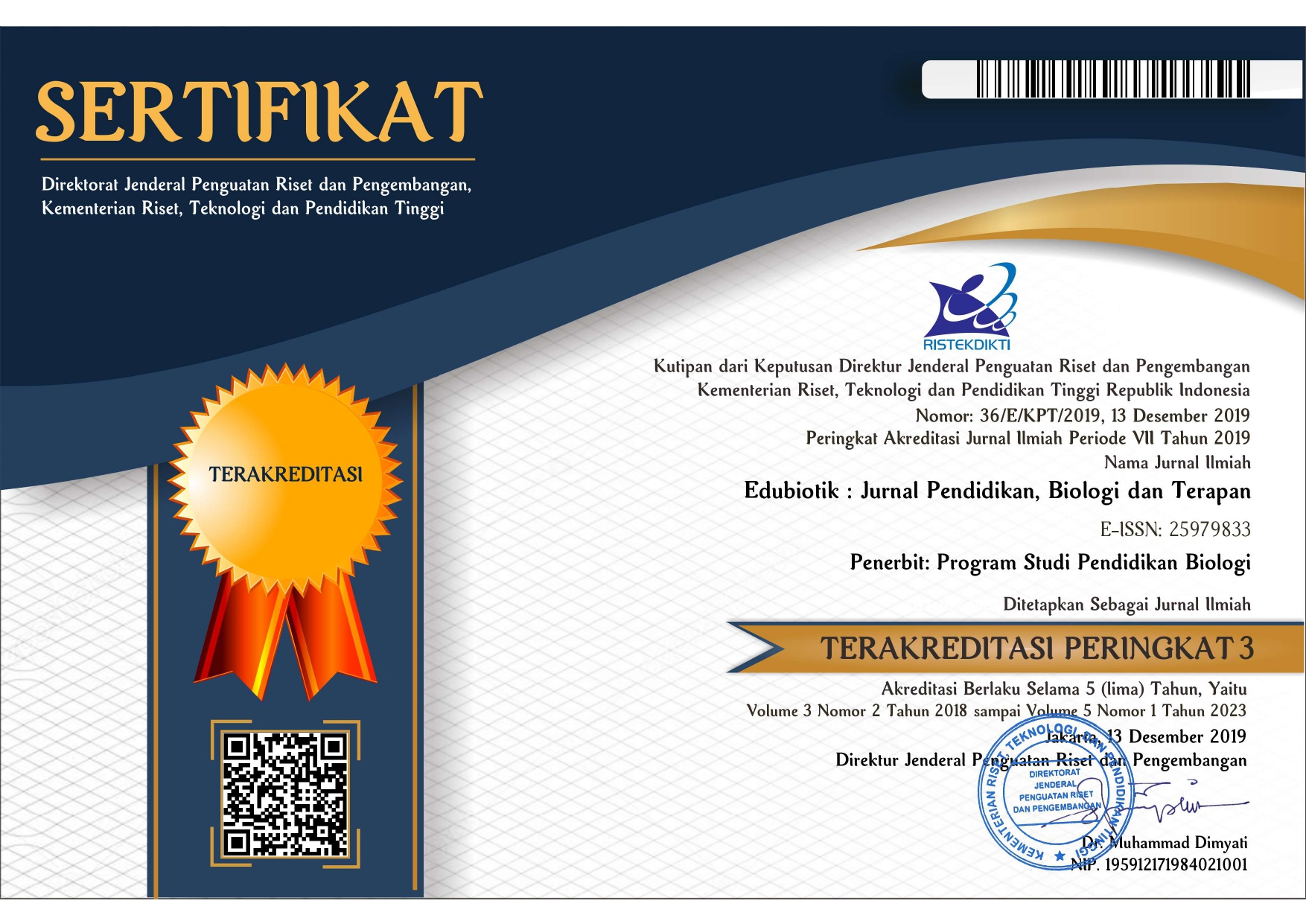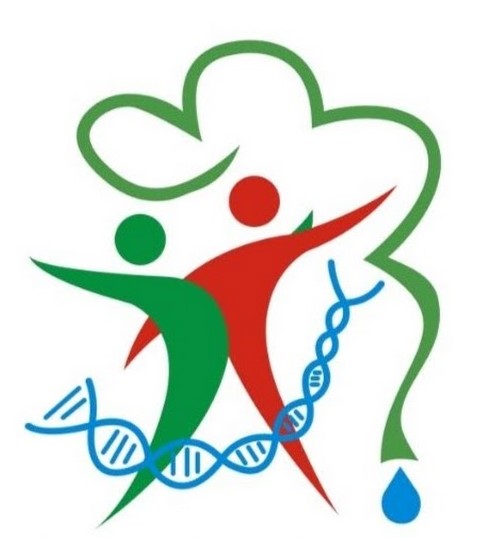Identification and analysis of aromatic components in Piper sarmentosum Roxb. from Meru Betiri National Park
Abstract
Piper sarmentosum Roxb or known as mana Karuk is an aromatic plant that has extraordinary potential, namely as a mucus expectorant, its roots are efficacious as a ureter and overcome gallstones. This plant is also used as an asthma drug, a cure for skin diseases such as tinea versicolor, stomach pain, malaria medicine, relieve bone pain and dental pain. The components of aromatic chemical compounds in the leaves and fruits from Meru Betiri National Park (MBNP) have not been identified. This study aimed to identify and analyze the aromatic components of P. sarmentosum leaves and fruits from MBNP using SPME-GCMS. The research method is laboratory research. The research samples and research materials were the leaves and fruit of the P. sarmentosum plant taken in MBNP. The SPME-GCMS tool is used in research to identify and analyze aromatic compounds. The research instrument used was an identification and analysis sheet of aromatic compounds from the P. sarmentosum plant. The data analysis technique uses the SPME-GCMS test. The results of the study showed that there were 46 volatile compounds found in the leaves, while in the fruit there were 29 volatile compounds. The main aromatic compound groups in the leaves and fruits of P. sarmentosum are terpenes, namely monoterpene. The other components consist of organic benzene compounds. P. sarmentosum Roxb. has 46 aromatic compounds in the leaves and 29 other aromatic compounds found in the fruit. Furthermore, research results must be tested in more depth regarding biological activity and mechanism of action through the best methods so that they can be recommended as new drug innovations in society.
References
Arief, R. (2019). Taman Nasional Meru Betiri. https://merubetiri.id/website/detailkonten/13
Azlina, M., Qodriyah, H., Akmal, M., Ibrahim, I., & Kamisah, Y. (2019). In vivo effect of Piper sarmentosum methanolic extract on stress-induced gastric ulcers in rats. Arch.Med.Sci, 15(1), 223-231. https://www.ncbi.nlm.nih.gov/pmc/articles/PMC6348366/
Chanprapai, P., & Chavasiri, W. (2017). Antimicrobial activity from Piper sarmentosum Roxb. against rice pathogenic bacteria and fungi. Journal of Integrative Agriculture. 16 (11), 2513-2524. https://doi.org/10.1016/S2095-3119(17)61693-9
Chen, C., Zhou, L., Wang, D., & Zhou, H. (2019). Study on antioxidant and anti-inflammatory effects of extracts from Piper sarmentosum Roxb. in vitro. China Animal Husbandry and Veterinary Medicine, 46(3), 677-683. https://www.chvm.net/EN/10.16431/j.cnki.1671-7236.2019.03.005
Chieng, T. C., Assim, Z. B., & Fasihuddin, B. A. (2008). Toxicity and antitermite activities of the essential oils from Piper sarmentosum. The Malaysian Journal of Analytical Sciences, 12(1), 234-239. http://www.ukm.my/mjas/v12_n1/32.pdf
Choochote, W., Chaithong, U., Kamsuk, K., Rattanachanpichai, E., Jitpakdi, A., Tippawangkosol, P., Chaiyasit, D., Champakaew, D., Tuetun, B., & Pitasawat, B. (2006). Adulticidal activity against Stegomyia aegypti (Diptera: Culicidae) of three Piper spp. Revista do Instituto de Medicina Tropical de São Paulo, 48(1), 33-37. https://doi.org/10.1590/S0036-46652006000100007
Cox-Georgian, D., Ramadoss, N., Dona, C., & Basu, a. C. (2019). Therapeutic and medicinal uses of terpenes. Medicinals Plants, 333-359. https://doi.org/10.1007/978-3-030-31269-5_15
Daud, U., Azahar, A., Abidin, S., & Tawang, A. (2015). The effects of Cosmos caudatus and Piper sarmentosum aqueous extracts on male mice fertility. IJPPS, 7(12), 296-298. https://journals.innovareacademics.in/index.php/ijpps/article/view/8533
Diastuti, H., Syah, Y. M., Juliawaty, L. D., & Singgih, M. (2014). Antibacterial activity of germacrane type sesquiterpenes from Curcuma heyneana rhizomes. Indonesian Journal of Chemistry, 14(1) 32-36. https://jurnal.ugm.ac.id/ijc/article/view/21264/0
Heriyanto, M. N. (2006). Keanekaragaman jenis pohon yang berpotensi obat di Taman Nasiona Meru Betiri. Jurnal Penelitian Hutan dan Konservasi Alam (JPHKA), 3(1), 55-64. https://doi.org/10.20886/jphka.2006.3.1.55-64
Hussain, K. H. (2012). A review of the literature and latest advances in research of Piper sarmentosum. Pharmaceutical Biology, 50(8), 1045-1052. https://doi.org/10.3109/13880209.2011.654229
Kamatou, G. P. (2008). Linalool – A review of a biologically active compound of commercial importance. NPC, 3(7), 1183 - 1192. https://doi.org/10.1177/1934578X0800300727
Lu, Jin-Jian, Dang, Yuan-Ye, Huang, Min, Xu, Wen-Shan, Chen, Xiu-Ping, & Wang, Yi-Tao. (2012). Anti-cancer properties of terpenoids isolated from rhizoma curcumae. Journal of Ethnopharmacology, 143(2), 406-411. https://doi.org/10.1016/j.jep.2012.07.009
Perveen, S., & Al-Taweel, A. (2018). Terpenes and terpenoids. IntechOpen. https://www.intechopen.com/books/6530
Qin, W. Y., Huang, S. C., Li, C. X., Chen, S. T., & Peng, Z. Q. (2010). Biological activity of the leaves of Piper sarmentosum Roxb (Piperaceae) and its chemical constituens on Brontispa longissima (Gestro) (Coleoptera:Hispidae). Pesticide Biochemistry and Physiology, 96(3), 132-139. https://doi.org/10.1016/j.pestbp.2009.10.006
Rameshkumar, K. B., Nandu, T. G., Anu Aravind, A. P., Mattew, S. P., & Shiburaj. (2017). Chemical composition and ftsz gtpase inhibiting activity of the essential oil of Piper sarmentosum from Andaman Islands India. Journal of Essential Oil Research, 29(5), 430-435. https://doi.org/10.1080/10412905.2017.1303405
Subramaniam, V., Adenan, M., Ahmad, A., & Sahdan, R. (2003). Natural antioxidants: Piper sarmentosum (Kadok) and Morinda elliptica (Mengkudu). Malaysian Journal of Nutrition, 9(1), 41-51. https://pubmed.ncbi.nlm.nih.gov/22692531/
Sun, X., Chen, W., Dai, W., Xin, H., Rahmand, K., Wang, Y., Zhang, J., Zhang, S., Xu, L., & Han, T. (2020). Piper sarmentosum Roxb.: A review on its botany, traditional uses, phytochemistry, and pharmacological activities. Journal of Ethnopharmacology, 263, 112897. https://doi.org/10.1016/j.jep.2020.112897
Taman Nasional Meru Betiri. (2022). Statistik balai Taman Nasional Meru Betiri tahun 2021. Jember: Kementerian Lingkungan Hidup dan Kehutanan, Direktorat Jenderal Konservasi Sumber Daya Alam Dan Ekosistem, Taman Nasional Meru Betiri. https://merubetiri.id/
Tuntiwachwuttikul, P., Phansa, P., Pootaeng-on, Y., & Taylor, W. C. (2006). Chemical constituents of the roots of Piper sarmentosum. Chemical and Pharmaceutical Bulletin, 54(2), 149–151. https://doi.org/10.1248/cpb.54.149
Turkez, H., Togas, B., Tatar, A., Geyıkoglu, F., & Hacımuftuoglu, A. (2014). Cytotoxic and cytogenetic effects of α-copaene on rat neuron and N2a neuroblastoma cell lines. Biologia, 69, 936–942. https://doi.org/10.2478/s11756-014-0393-5





.png)
2.png)

1.jpg)


